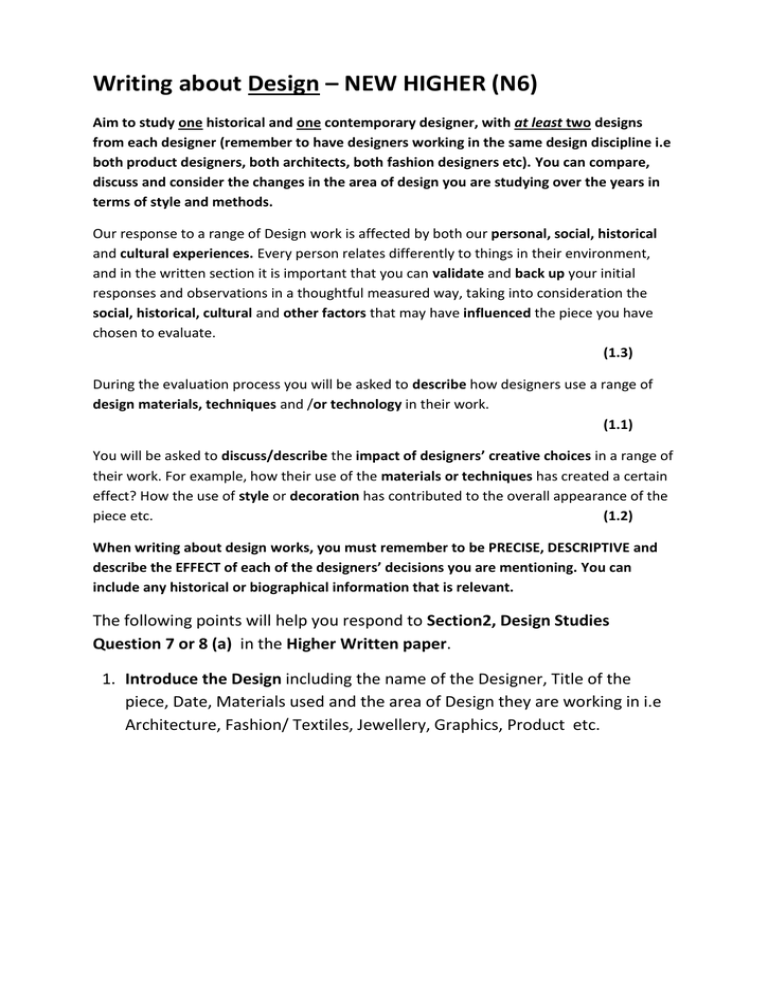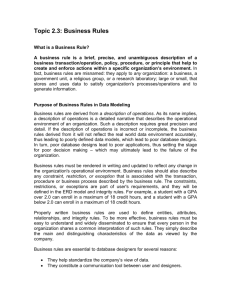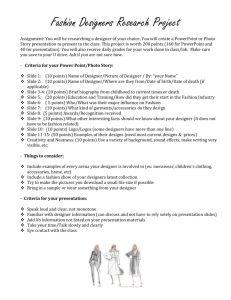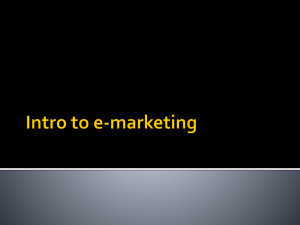Writing about Design – NEW HIGHER (N6)
advertisement

Writing about Design – NEW HIGHER (N6) Aim to study one historical and one contemporary designer, with at least two designs from each designer (remember to have designers working in the same design discipline i.e both product designers, both architects, both fashion designers etc). You can compare, discuss and consider the changes in the area of design you are studying over the years in terms of style and methods. Our response to a range of Design work is affected by both our personal, social, historical and cultural experiences. Every person relates differently to things in their environment, and in the written section it is important that you can validate and back up your initial responses and observations in a thoughtful measured way, taking into consideration the social, historical, cultural and other factors that may have influenced the piece you have chosen to evaluate. (1.3) During the evaluation process you will be asked to describe how designers use a range of design materials, techniques and /or technology in their work. (1.1) You will be asked to discuss/describe the impact of designers’ creative choices in a range of their work. For example, how their use of the materials or techniques has created a certain effect? How the use of style or decoration has contributed to the overall appearance of the piece etc. (1.2) When writing about design works, you must remember to be PRECISE, DESCRIPTIVE and describe the EFFECT of each of the designers’ decisions you are mentioning. You can include any historical or biographical information that is relevant. The following points will help you respond to Section2, Design Studies Question 7 or 8 (a) in the Higher Written paper. 1. Introduce the Design including the name of the Designer, Title of the piece, Date, Materials used and the area of Design they are working in i.e Architecture, Fashion/ Textiles, Jewellery, Graphics, Product etc. DESIGN ISSUES: How has the Designer used the following Design Issues Aesthetics/ Style (How it looks) Is it pleasing to the eye? 2. Describe the look/ style of the design. Is the design clumsy, elegant, geometric, futuristic, decorative, minimal, fussy? What effect has this created ? Chic, Classic, Hollywood Glamour, Body Hugging, Unisex, Fluid, Functional, Tailored, Austere, Formal, Structured, Nipped in waist, Graceful, Minimalist, Curvaceous, Lean, Close fitting, Shaped to the natural line of the body, Symmetrical, Asymmetric, Wrap around, Detailed, Dramatic, Tasteful, Dramatic, Exotic, Witty, Humorous, Stunning, Exciting, comic, Sophisticated, Elegant, Luxurious, Highly Individual, Intricate, Innovative, Flattering, Romantic, Lavish, Casual, Flirtatious, Trendy, Revealing, Crazy, Fantasy, Daring, Refined, Conservative, Dazzling, Inspired, Understated, Sensible, Plain, Disciplined, Off-Beat, Glamorous, Desirable, Imposing, Important, Oriental, Eastern, Ingenious, Inventive, Artistic, Aesthetic, Urban, Street, Refined, Astonishing, Spectacular, Discreet, Graceful, Mass-produced, one-off, Hand-made, Bespoke, Haute Couture, Custom made, Customised, Biased cut, Provocative, Avant-garde, Cutting edge, Eccentric, Exuberant, Ethnic, Industrial, Spacious, Retro, Modern, Modest, Sombre, 3. What was the designers source of inspiration do you think for this design? Does the style relate to/ or does it remind you of a particular time in history? Why? 4. Ergonomics –Discuss how the design interacts with the human body How comfortable is it to use? Is the garment/object easy to use? Comment on the weight/ size of the garment/object. Is it important? 5. Fitness for Purpose- Form over Function or Function over Form? Function – the purpose of the design Is the design more about the look and style (form) or how it works (function)? What effect does this have on the design? 6. Materials/ technology/techniques What materials have been used in the production of your chosen design? How does this affect the overall look of it? Is it well-made, durable? What manufacturing process/ production methods/ different techniques have been used? Have the methods changed over the years? In what ways? How does the production relate to the market cost of the design? Resin, Concrete, Metal, Steel, Tubular steel, Brick, Cement, Glass, Wrought Iron, Cladding, Wood, Shingles, Rendering, Stone, Granite, Thatch, Slate, Aluminium, Titanium, Clay, Sand, Natural, Man- made, Wattle and Daub, Plastics, Fabric membranes, Tensile Fabric, Steel cables, Cotton, Satin, Silk, Straw, Felt, Fleece, Wool, Feathers, Plumes, Lycra, Velvet, Devore (Velvet with a pattern burned into it with a special screen printing paste), Leather, Leather look, PVC, Acrylic, Tartan, Tweed, Muslin, Viscose, Water-proof, Paper, Plastic, Tin, Metal, Sequinned, Transparent, Lace, Opaque, Crepe, Chiffon, Cashmere, Jersey, Pinstriped, Tulle, Denim, Hardwearing, Delicate, Filmy, Wind Proof, Woven, Open Weave, Fur, Fun/Fake Fur, Machine made, Handmade, Lasercut, Industrial process, Digital printing, 3-D Printed, Moulded, Silk Screen printed, Machine Stitched, Hand stitched, Embroidered ,Vacuum formed, knitted, 7. Target Market – Who is the design aimed at? Why do you think this is? Do you think it would appeal to this market? Why? In what ways? Men in their 20’s to 30’s, for the more mature woman, for the sophisticated girl about town, for the extrovert celebrity, for the school girl market, aimed at the most outrageous personalities, for model type figures only, Strictly for the over 20’s etc, not for the faint hearted, not for middle aged mum at the school gates!, for the most feminine of women, for the more masculine type of woman, for business people, for the rich and famous, for anyone who loves the unmistakeable style of designer label clothes, for glamorous, leggy types, for anyone who wants to be noticed, for anyone who loves the wow factor, for anyone who is comfortable with skimpy clothing, Ready to wear market How has the designer used the following visual elements 8. Colour- How does the designer’s use of colour affect the design? Dramatic, Flamboyant, Exotic, Warm, Cool, Beautiful, Vibrant, Bold, Lively, Romantic, Delicate, Soft, Hard, Earthy, Jewel-like, Hot, Off-Beat, Outrageous, Modest, Sombre, Imposing, Dazzling, Retro, Modern, Patel, Neon, Day-Glo, Bright, Cheerful, Whacky, Contemporary, Tint, Shade, Hue, Seductive, Punk, Grungy, Dull, Unusual, Combinations, Contrasting, Dynamic, Rich, Metallic, Pearly, Distinctive, Wild, Graduated, Intense, Milky, Opaque, Transparent, Gothic, Fantastic, Rainbow, Gorgeous, Wonderful, Riot of Colour, Fusion, Muddy, Burnt, Velvety, Clean, Ordinary, Clear, Misty, Primary, Secondary, Childlike, Blend, Mixture 9. Line- Does the designer use certain types of line? Does the designer vary the type of line used in different areas of the design? How does that affect the look of the piece? Languid, Bold, Straight, Curved, Wavy, Wiggly, Broken, Thick, Thin, Wide, narrow, Whiplash, Organic, Sinuous, Elegant, Sharp, Rigid, Right angles, Fine, Vigorous, Energetic, Jaggy, Heavy, Feathery, Erratic, Sweeping,Tapered 10. Pattern/Texture- Describe how pattern and texture has contributed to the overall appearance and has added interest and detail to the piece. Repeat pattern, Bold, Symmetrical, Half drop repeat, Regular, Irregular, Organic, Brickwork, Rhythmic, Flowing, Dotted, Busy, Intricate, Geometric, Detailed, Ornate Irregular, Soft, Smooth, Rough, Coarse, Shiny, Woven, Polished, Raised, Bumpy, Embossed, Padded, Treated, Plastered, Rendered, Burnished, Reflective, Gleaming, Metallic, Sharp, Fleecy, Woolly, Furry, Fluffy, Silky, Prickily, Stippled 11.Shape / Form /Scale – Discuss how shape and form has been used in the piece. Has more organic, natural features compared to more geometric, mechanical forms been used to create the piece. How does scale impact the overall shape and form of the work? Flat, abstract, simple, symmetrical, stylistic, complex, basic, geometric, sculptural, solid, severe, delicate, airy, rounded, curvaceous, smooth, bulbous, graceful, massive, enlarged, miniature, minute, Sculptural, Fitted, Figure hugging, Wraparound, Hourglass, Neat, Bold, Geometric, Flowing, Unstructured, Loose, Undulating, Abstract, Exciting, Dramatic, Stylish, Flexible, Restrictive, Daring, Swirling, Sophisticated, Uncluttered, Balanced, Explosive, Flamboyant, Simple, Complicated, Individual, Elegant, Clean, Fluid, Rigid, Floppy, Tubular, Conical, Curved, Arching, Fish tail, Tulip, Balloon, Flared, Sheath, Pencil, Heart, Funnel, Strong, Angular, Oblong, Square, Even, Funnel, Pyramid, Proportion, Large, Gigantic, Monumental, Exaggerated, Huge, Enormous, Big, Immense, Massive, Substantial, Tall, Wide, Full-Sized, Insignificant, Miniscule, Tiny, Diminutive, Minute, Dainty, Petite, Lofty, Scale 12.Opinions: How successful do you think the design is? Why? Describe any reservations (things you don’t like) that you may have towards them and why? What changes, if any, would you make to the design? Why? *Relation to the older design only. Are there still designs like this today? If there are, why has this style stood the test of time? What do you think about the designers’ work in general? Why do you think this designer/fashion house has been so successful? What is its overall style and what is its impact on the fashion of today? 13.Context: (this would be used in the part(b) section of Question 7 or 8 and would be scored out of 10. Explain the influence of social, cultural and /or other factors on the design work discussed What led the designer to create the piece? What was going on in his/her life at the time/ what stage was he/she at during his/her career? Does the piece belong to a particular style or movement? What was the movement about? What is your opinion of this style? How does it compare with other works by the designer? Who influenced them? Why? Who did they then influence? Why? Abstract, semi-abstract, naturalistic, sculptural, symbolic, imaginative, dreamlike, illustrative, matter of fact, naïve, child – like, bold, realistic, understated, graphic, stark, Art Nouveau, Art Deco, Bauhaus, Modernist, De-Constructionist, Contemporary,






